Irish heritage charity warns that these buildings of importance to Ireland's heritage are in such a state of disrepair that they could be lost to future generations.
An Taisce, a charity that works to preserve and protect Ireland’s natural and built heritage, has assembled for the fifth time what it determines to be the country’s "Top Ten Most At-Risk Buildings".
These are all buildings of importance, both intrinsically and to the heritage of their local areas; buildings that lie vacant and are in such a state of disrepair that they may be dangerous or have no identifiable new use. These buildings could be lost to future generations unless direct action is now taken to preserve them.
An Taisce’s Head of Advocacy Ian Lumley said, “We are seeing widespread vacancy and dereliction of heritage buildings in Irish towns and cities. The House by the Churchyard in Chapelizod which was on our 2020 top ten buildings at-risk list is one example. The one-time home of one of Ireland’s most iconic horror writers Sheridan Le Fanu, and a fine example of an 18th-century house is being left to deteriorate. Le Fanu is now part of an equally scary story as his famed, The House by the Churchyard novel, that of dereliction and vacancy”.
Read more
Mr. Lumley continued, “There is so much opportunity in restoration and conservation. In these pandemic times, we have seen the value of community and a growing appreciation for spending time and getting to know our local areas. Together with a homeless crisis that has not gone away, offer a compelling argument to save and repurpose many of the buildings listed below and many more for either community or residential use. Restoring and repurposing heritage buildings is also far more sustainable than allowing them to deteriorate, bulldozing them, and constructing new developments from scratch”.
In alphabetical order, the ten buildings deemed most at risk in 2021 are:
Aldborough House, Dublin 1
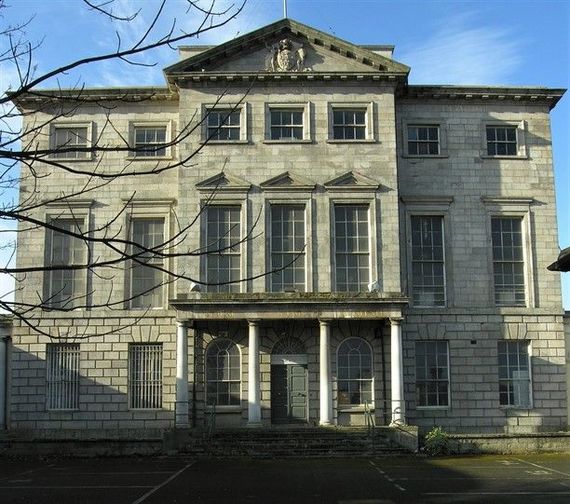
Aldborough House, Dublin 1.
Aldborough House is one of Dublin’s finest 18th-century mansions, which just happens to be in the north inner-city; a reason, some might argue, that it has endured years of neglect and dereliction.
Aldborough should be a landmark building; instead, it is in a shambolic state. Second, in size only to Leinster House, this Georgian townhouse was built in the late 1790s for the 2nd Earl of Aldborough, and for periods it has been used as a school, a barracks, and a post office depot.
It became vacant around the year 2000 and was sold by the State. Roof repairs have been carried out by Dublin City Council, and a planning application is currently being prepared under new ownership.
Built: 1790s
Recommended use: Residential/Commercial/Educational
Bishop's Palace, Raphoe, Co. Donegal
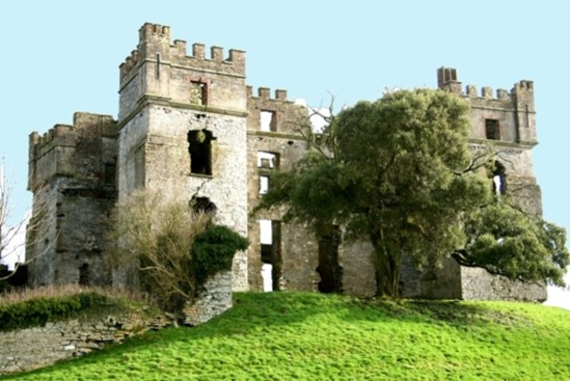
Bishop's Palace, Raphoe, Co. Donegal.
The Bishop’s Palace is a roofless shell. Unfortunately, none of the original fabric remains other than the external walls. But worryingly, it is now suffering from structural problems that could lead to a full or partial collapse.
Situated on a prominent hilltop position, the Bishop’s Palace still remains an arresting sight. The former Church of Ireland bishop’s residence, also known as Raphoe Castle, dates back to the 1630s and retains much of its early imposing character and form. Its brooding presence, to the southeast of the center of Raphoe, can be seen from a number of different locations around the town.
Incredibly, it remains today an imposing and impressive ruin and stands as one of the most striking and important castles in Donegal.
Built: 1636
Recommended use: Conservation
Canal Hotel, Robertstown, Co. Kildare
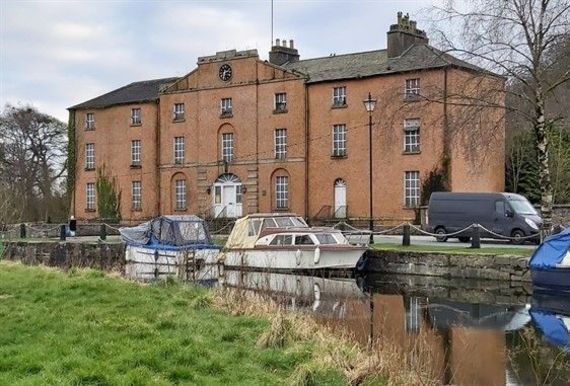
Canal Hotel, Robertstown, Co. Kildare.
The Canal Hotel opened in 1801 with expectations grounded on provident and astute rationale: it would cater for the growing traffic along the near-complete Grand Canal. Early returns were certainly encouraging too; so, accordingly, an extension was added in 1804 (the year that the canal was officially opened). Regrettably, the owners could not have foreseen the arrival of the railways. Steam engines appeared on the scene a few decades later and, with that, revenues began to fall. In 1849, the hotel closed its doors for the last time.
The hotel lay vacant for a while until it was converted into a military barracks, before happily returning to its original use somewhat, in 1942, when Bord na Móna repurposed it as a hostel or "turf camp" for workers who were producing fuel during ‘The Emergency’ (1939-46). Towards the end of the 20th century, the building was converted into a museum/gallery.
Ominously now, though, the building has lain vacant for several years. To add to its current misfortune, it appears not to have been well maintained. Shamefully so, because it is a property of huge local significance; it makes such a wonderful visual statement overlooking the Grand Canal, too, that it ought to be brought back into active use as soon as possible.
Built: c.1800
Recommended use: Residential/Community/Commercial/Educational
Castle MacGarret, Claremorris, Co. Mayo
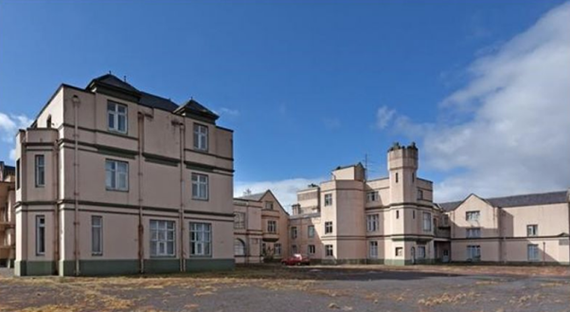
Castle MacGarret, Claremorris, Co. Mayo.
Castle MacGarret lies about three kilometers south of Claremorris. The site was associated with the Browne family for more than 350 years, and perhaps not surprisingly – one glance might tell you – the present house has had a complicated history.
The original castle stood closer to the Robe River, but towards the end of the 17th century it was found to be unsafe, thus a new residence was built away from the water. Several generations of the Brownes lived in that manor until a fire broke out. As a consequence, the third Lord Oranmore and Browne (1861-1927) employed Richard Caulfield Orpen, the brother of painter Sir William Orpen, to construct a new manor which he did by remodeling and extending the old stables. Although the revamp may not exactly captivate – the exterior does lack a certain grace – the interior is more appealing.
In 1964, the Irish Land Commission bought Castle MacGarret, and its surrounding 1,750 acres, for a sum of £95,000. Then, having parcelled out most of the estate among local farmers, the organization put the house and surrounding 125 acres up for sale. The new owners, the Sisters of Our Lady of Apostles, tacked on an unfortunate and incongruous extension. The property operated as a retirement home until 2005 when, at the height of Ireland’s economic boom, the wily nuns sold the house and its grounds for approximately €5 million. A business consortium intended to convert the property into a hotel and spa, but the recession put an end to that plan.
Castle MacGarret now sits idle and prey to damp, which seeps through every missing slate. Another part of Ireland’s architectural and social heritage could disappear into the saturated ground below unless a new use for the building is urgently found. There was a change of ownership in 2016, but no conservation work has yet been carried out.
Built: 1800-1811
Recommended use: Residential
Read more
Castle Saunderson, (near Belturbet) Co. Cavan
Castle Saunderson was once home to a hugely significant Anglo-Irish family; most notably, Colonel Edward Saunderson, who was the founder of modern Irish Unionism. Edward Saunderson led the Irish Unionist Alliance party from 1891 until his death in 1906. The Saundersons were a 17th-century branch of an old English family, who originally came from Durham.
What we see now may be a ruin, but at the core of Castle Saunderson is a classical house of significant architectural interest built by Francis Saunderson around the time of his marriage in 1779. And what emerged out of that, in the mid-1830s, was a fine Gothic Revival country home. In the 18th century, it was one of the most important country demesnes in Cavan, comprising of over 12,000 acres.
Although the Saundersons abandoned the property in 1927, it wasn’t until 1977 that they sold it to a businessman, and he undertook some much-needed restoration work. For a while, it became a hotel before being sold again in the 1990s, after which it was gutted by fire. In 1997, Castle Saunderson and its grounds were acquired by Scouting Ireland. Sadly, as is the case with so many of Ireland’s dilapidated and heritage buildings, restoration was not the chosen option; instead, the scouts constructed a new center elsewhere on the grounds at a cost of €3.7 million.
In the meantime, the old castle stands forlorn and continues to deteriorate.
Built: c. 1835
Recommended use: Conservation/Management
Charter School, Monasterevin, Co. Kildare
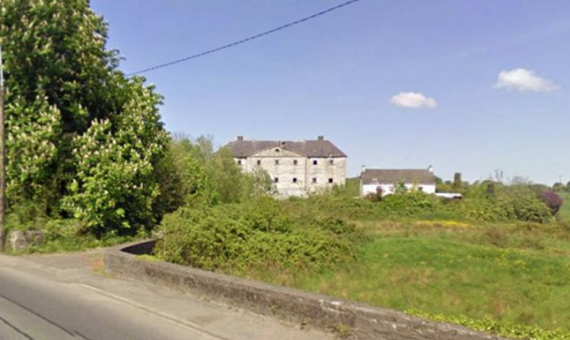
Charter School, Monasterevin, Co. Kildare.
Charter School, a seven-bay with pediment from the mid-18th century, and known locally as ‘The Hulk’, is one of the earliest educational institutions in the area. It was established to provide education for orphaned Protestant children, one of many schools of its kind built under royal charter by ‘The incorporated society for promoting protestant English schools in Ireland’. Two small entrances, right and left, allowed girls and boys access. The boys were usually taught a trade which they could then be apprenticed into once they had reached early teens. The building was later re-purposed as a warehouse in the 1870s, and the windows were reduced in size.
Regrettably, however, it has now lain vacant for several years.
In March 2019, a planning application was refused by Kildare County Council for its refurbishment and conversion, to provide 99 residential properties on the site.
Sadly, like many other heritage buildings in Monasterevin, ‘The Hulk’ remains in a ruinous state. However, it is an impressive example of Georgian industrial architecture, and one of the finest to survive. But for how much longer? Urgent remedial works need to be carried out lest the building sharply deteriorates. Most of the external fabric remains intact, but there are worrying signs of deterioration, including broken windows and vandalism.
Built: c. 1755
Recommended use: Residential/Educational

Love Irish history? Share your favorite stories with other history buffs in the IrishCentral History Facebook group.
Debtor's Prison, Green Street, Dublin
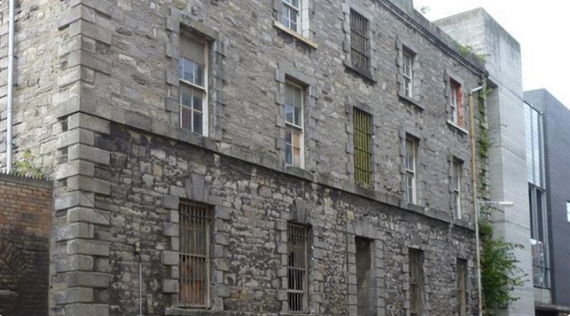
Debtor's Prison, Green Street, Dublin.
The Debtor’s Prison lies in the heart of Dublin, in the markets area, which is an urban quarter desperately in need of a cohesive and long-term Council plan – that is, before developers are allowed to carve it up.
The prison stands next to Green Street Courthouse, where Robert Emmet famously delivered his speech from the dock in 1803. It is a three-story over basement U-plan built on the north side of the former City Court and jail complex. Works were carried out in 2011 by the OPW to conserve part of the entrance wall on Halston Street. Being a building of significant historic importance, however, it requires additional conservation work to prevent further deterioration.
The prison, which was later repurposed as an RIC barracks before being put to use as a Garda station, once accommodated up to a hundred detainees in varying levels of comfort. It was built to replace ‘sponging’ houses, where debtors were held by bailiffs, often extortionately until their debt was repaid. In the 19th century, laws against debtors were severe, and there were five debtors’ prisons in Dublin in 1841. This particular one has survived in a largely intact state, most probably due to its continuous use.
Built: 1794
Recommended use: Residential/Commercial/Community/Educational
Donaghy’s Mill, Drogheda, Co. Meath
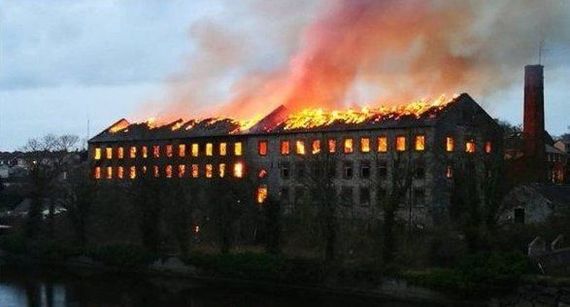
Donaghy’s Mill, Drogheda, Co. Meath.
For two centuries, Donaghy’s Mill has held a special place in the hearts and minds of people from Drogheda. And so when a devastating fire broke out in 2019, consuming almost the entire building, it was greeted with shock and sadness by locals.
The landmark mill is situated in a prominent position on the River Boyne, to the west of the town centre. It was once the home of the West Gate Flax Mill, although when Edward Donaghy came to Drogheda in 1932, it had already been vacated. He bought it and repurposed the site for his expanding shoe manufacturing business. The mill then remained in private hands until the company sold it to a consortium of local businesspeople in 1972.
Prior to fire breaking out, the building had been left vacant for several years. Nevertheless, it was in the process of being sold to a company interested in developing the site as a hotel; the Council had previously shunned a great opportunity to buy the entire site in 2014 at a knockdown price.
The fire that occurred on St Patrick's Day two years ago has reduced the main part of the five-storey mill to a shell. Urgently action needs to be taken and new uses identified to prevent any further deterioration of its character.
Date: c. 1820
Recommended use: Residential/Commercial/Community
Read more
Knocklofty House, near Clonmel, Co. Tipperary
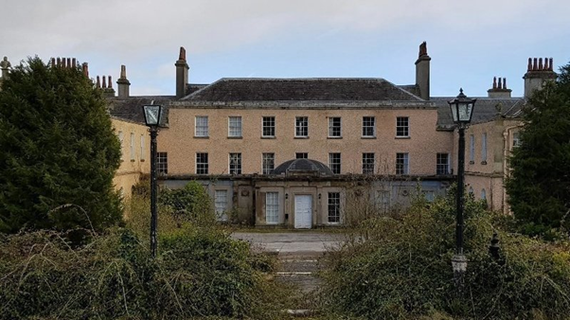
Knocklofty House, near Clonmel, Co. Tipperary.
Knocklofty House is a fine 18th-century residence that is being badly damaged by illegal occupancy. The once spacious and finely decorated interior has been threatened in recent years by squatters and damaged by theft and vandalism.
Truly, the building is in a sad state of disrepair: lead has been stripped from the roof, and it now lies partially exposed to the elements which could lead to further internal damage. Appeals have been made in Co. Tipperary for protection and preservation works to be carried out on the site.
This former country house served as the seat of the Donoughmores until the mid-1980s. In 1974, it became the focus of national attention when Lord and Lady Donoughmore were kidnapped by an IRA gang. The couple were subsequently released in the Phoenix Park, in Dublin, after being held captive for five days.
The property has mostly operated as a hotel since the mid-1980s, but the house and 80 acres were back on the market in 2013, selling for considerably less than the €3 million asking price. However, ownership is being disputed by US private equity firm, Cerberus Capital, and local businessman Denis English.
The property is listed on Tipperary County Council's Record of Protected Structures, and an 'enforcement officer' has been on-site to carry out an inspection. Nevertheless, its current state has caused a lot of anger and dismay locally, and a campaign group has been formed to try and prevent any further damage from occurring.
Built: c. 1790
Recommended use: Residential/Community/Commercial/Educational
The House by the Churchyard, Chapelizod, Dublin 20
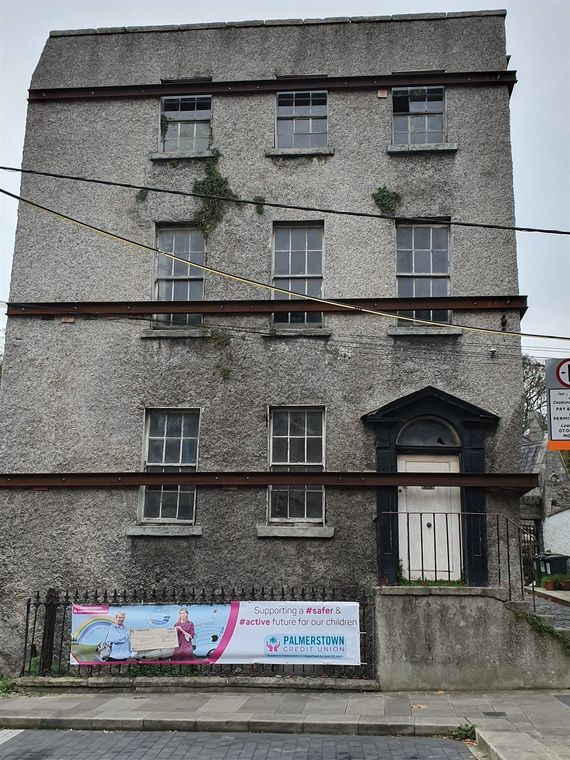
The House by the Churchyard, Chapelizod, Dublin 20.
Several heritage buildings stand derelict in the pretty suburban village of Chapelizod, but none can match the eminence and literary connections of Number 34, Main Street: a house that is synonymous with the novel The House by the Churchyard, which subsequently became an inspiration for James Joyce’s Finnegan’s Wake.
Sheridan Le Fanu’s 1863 novel was set in the 1760s, just a few decades after the eponymous house was constructed, and for most of its existence, it has stood in the center of this heritage village: a fine, imposing building in front of the medieval bell tower of St Laurence’s Church. Although number 34 remains in situ today, it is now in a shamefully poor condition. The house has deteriorated at such a rate over the past few years that the internal structure has disappeared; the floors and roof collapsed earlier this year and the front façade and eastern gable now appear to be bowing. Its four walls are being held up instead by supportive steelwork.
The House by the Churchyard was the early childhood home of Le Fanu and is a well-proportioned early Georgian building: a detached, three-story house with a small, (now overgrown) yard in the lee of the western gable. Le Fanu wrote the book in serial form and thus the finished novel has a rather convoluted plot. The fate of the house, around which his narrative forms, ought to be less intricate today and deserving of a more positive outcome.
Built: c. 1740
Recommended use: Residential
For a full report visit AnTaisce.org.

Love Irish history? Share your favorite stories with other history buffs in the IrishCentral History Facebook group.
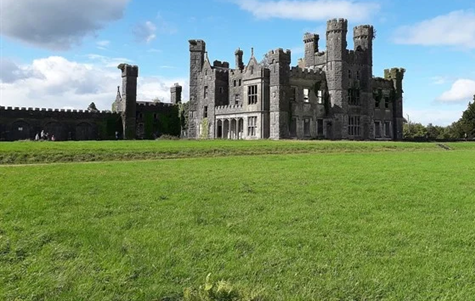



Comments